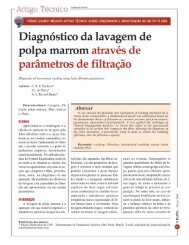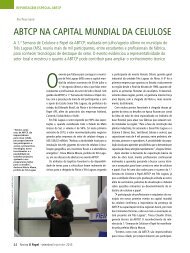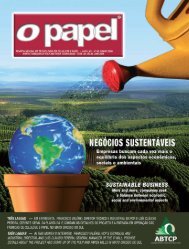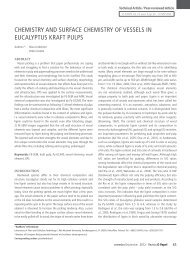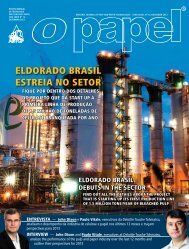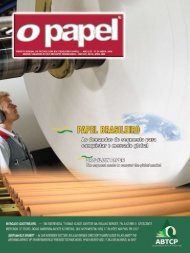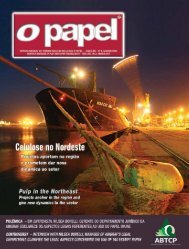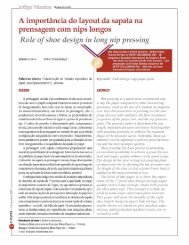international article - Revista O Papel
international article - Revista O Papel
international article - Revista O Papel
You also want an ePaper? Increase the reach of your titles
YUMPU automatically turns print PDFs into web optimized ePapers that Google loves.
Tabela 1. Lista de todas as amostras estudadas e condições pertinentes / Table 1. List of all samples studied and pertinent conditions<br />
Amostras<br />
Samples<br />
Não-tratada<br />
Untreated<br />
Teor umidade antes da<br />
impregnação (%)<br />
Moisture content before<br />
impregnation (%)<br />
Temperatura<br />
de cura ( o C)<br />
Curing<br />
temperature (°C)<br />
Tempo de cura<br />
(min)<br />
Time of curing<br />
(min)<br />
WPG (%)<br />
WPG (%)<br />
Conversão<br />
química<br />
Chemical<br />
conversion<br />
- - - - 0.00<br />
1 6.14 140 3.00 97.2 0.28<br />
2 5.78 140 3.00 90.0 0.05<br />
3 6.21 138 5.00 90.1 0.26<br />
4 5.31 138 5.00 77.4 0.25<br />
5 6.21 140 7.00 75.4 0.32<br />
6 5.50 140 7.00 72.0 0.38<br />
7 5.50 160 3.00 70.1 0.47<br />
8 5.48 160 3.00 77.3 0.42<br />
9 5.27 160 5.00 72.9 0.62<br />
10 5.52 160 5.00 67.5 0.56<br />
11 6.78 160 7.00 68.3 0.66<br />
12 5.48 160 7.00 69.4 0.71<br />
13 6.14 180 3.00 74.2 0.72<br />
14 5.78 180 3.00 74.8 0.82<br />
15 5.52 180 5.00 73.4 0.88<br />
16 5.61 180 5.00 74.6 0.89<br />
17 5.27 180 7.00 75.6 0.88<br />
18 5.61 180 7.00 74.7 0.91<br />
Uma pequena parte de cada amostra foi analisada por<br />
meio de medições NIR utilizando um equipamento NIR<br />
FOSS SYSTEM 6500. Os espectros foram obtidos no modo<br />
de transmitância na faixa de comprimento de onda de 600-<br />
1900 nm com intervalos de 2 nm. Os espectros foram convertidos<br />
para o modo de absorbância e analisados mediante<br />
o software Unscrambler 2.0 ® (CAMU). Projeção para estrutura<br />
latente (PLS), regressão de componentes principais<br />
(PCR) e análise de componentes principais (PCA) foram as<br />
funções matemáticas usadas para a montagem de modelos<br />
e analise de dados dos espectros. Variação normal padrão<br />
(SNV), suavização da média móvel e primeira e segunda<br />
derivadas foram testadas como tratamento prévio do espectro<br />
para maximizar correlações e minimizar erros-padrão.<br />
A conversão química (ou grau de reação) foi avaliada<br />
por meio de equipamento DSC (TA Instruments, EUA). As<br />
amostras foram secadas em estufa a 40ºC sob vácuo durante<br />
24 h e condicionadas em dessecador antes da análise DSC.<br />
A conversão química foi avaliada depois de dois testes de<br />
DSC a temperatura modulada com rampa de 10ºC/min até<br />
200ºC e fluxo de N 2<br />
a uma taxa de 50 mL/min, usando amostra<br />
com massa de aprox. 5 mg. O fluxo de calor durante o<br />
primeiro teste é devido a eventos reversíveis e irreversíveis<br />
da resina em processo de cura e o segundo teste é associado<br />
somente com eventos térmicos reversíveis da resina curada.<br />
Portanto, a conversão química pode ser avaliada com base<br />
A small part of each sample was analyzed by<br />
NIR measurements using NIR FOSS SYSTEM 6500<br />
equipment. The spectra were obtained in transmittance<br />
mode over the wavelength range of 600-1900<br />
nm at 2 nm intervals. The spectra were converted to<br />
absorbance mode and analyzed using Unscrambler<br />
2.0 ® software (CAMU). Projection to latent structure<br />
(PLS), principal component regression (PCR),<br />
and principal components analysis (PCA) were the<br />
mathematical tasks used to construct models and analyze<br />
spectrum data. Standard normal variate (SNV),<br />
moving average smoothing, first and second derivatives<br />
were tested as a previous spectral treatment to<br />
maximize correlations and minimize standard errors.<br />
The chemical conversion (or reaction extent) was<br />
evaluated using DSC equipment (TA Instruments, USA).<br />
The samples were dried in an oven at 40oC under<br />
vacuum during 24 h and conditioned in a desiccator<br />
before DSC analysis. The chemical conversion was<br />
evaluated after two runs in the DSC at a modulated<br />
temperature ramp at 10oC/min until 200oC and N2 flow<br />
rate of 50 mL/min using a sample mass around 5 mg.<br />
The heat flux during the first run is due to reversible and<br />
irreversible events from the resin curing and the second<br />
run is associated only with reversible thermal events<br />
of the cured resin. Therefore, the chemical conversion<br />
O PAPEL - Outubro 2009 O PAPEL vol. 70, num. 10, pp. 62 - 71 OCT 2009<br />
65



